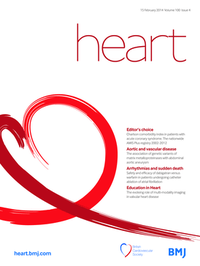Heart (journal)
Heart is a biweekly peer-reviewed medical journal covering all areas of cardiovascular medicine and surgery. It is the official journal of the British Cardiovascular Society. It was established in 1939 as the British Heart Journal and is published by the BMJ Group.[1] The name was changed from British Heart Journal to Heart in 1996 with the start of volume 75.
 | |
| Discipline | Cardiology |
|---|---|
| Language | English |
| Edited by | Catherine Otto |
| Publication details | |
Former name(s) | British Heart Journal |
| History | 1939-present |
| Publisher | BMJ Group |
| Frequency | Biweekly |
| Hybrid | |
| 5.420 (2017) | |
| Standard abbreviations | |
| ISO 4 | Heart |
| Indexing | |
| CODEN | HEARFR |
| ISSN | 1355-6037 (print) 1468-201X (web) |
| OCLC no. | 34055332 |
| Links | |
Topics covered include coronary disease, electrophysiology, valve disease, imaging techniques, congenital heart disease (fetal, paediatric, and adult), heart failure, surgery, and basic science. Each issue also contains an extensive continuing professional education section ("Education in Heart").
The journal is available online by subscription, with archives from before 2006 accessible free of charge. The editor-in-chief is Catherine Otto (University of Washington).[1]
In 2010, Heart launched a sister journal, Heart Asia. As the official journal of the Asia Pacific Heart Association, Heart Asia aimed to focus on cardiovascular research in the Asia Pacific region.[2] A second sister journal, Open Heart, was launched in 2010 with the aim of covering high quality cardiovascular research with less emphasis on novelty or priority.[3]
Abstracting and indexing
The journal is abstracted and indexed by Index Medicus, Science Citation Index, EMBASE, Google Scholar and Scopus. According to the Journal Citation Reports, its 2017 impact factor is 5.420, ranking it 22nd out of 128 journals in the category "Cardiac and Cardiovascular Systems".[4]
Editors-in-chief
The following persons have been editor-in-chief of the journal:
- D Evan Bedford, J M Campbell 1939-?
- K. Shirley Smith ?-1972
- Walter Somerville 1973-?
- Roger Hall ?-2006
- Adam Timmis 2007-2013
- Catherine Otto 2014–present
Most cited articles
According to Scopus, the following three articles from Heart have been cited most often (>700 times):[5]
Day, C. et al. (1990) QT dispersion: an indication of arrhythmia risk in patients with long QT intervals. British Heart Journal 63 (6):342-344 [6]
Jenni, R. et al. (2001) Echocardiographic and pathoanatomical characteristics of isolated left ventricular non-compaction: a step towards classification as a distinct cardiomyopathy. Heart 86 (6):666-671 [7]
Wilkins, G.T. et al. (1988) Percutaneous balloon dilatation of the mitral valve: an analysis of echocardiographic variables related to outcome and the mechanism of dilatation. British Heart Journal. 60 (4):299-308 [8]
References
- Heart Homepage
- Lim, Michael C L (2009). "A new journal focusing on cardiovascular disease in the Asia Pacific region" (PDF). Heart Asia. 1 (1).
- Meier P, Fröhlich GM, Knapp G, Mohiddin S, Goldacre B, Wang D, Kustosz C, DiNicolantonio JJ, Ebrahim S (2013-12-01). "Open Heart – The new BMJ cardiovascular journal, advocating open access, open peer-review and open data". Open Heart. 1 (1): e000007. doi:10.1136/openhrt-2013-000007. ISSN 2053-3624.
- "Journals Ranked by Impact: Cardiac and Cardiovascular Systems". 2014 Journal Citation Reports. Web of Science (Science ed.). Thomson Reuters. 2015.
- "Scopus search for Heart articles". Scopus. Retrieved 3 April 2018.
- Day CP, McComb JM, Campbell RW (June 1990). "QT dispersion: an indication of arrhythmia risk in patients with long QT intervals". British Heart Journal. 63 (6): 342–4. doi:10.1136/hrt.63.6.342. PMC 1024518. PMID 2375895.
- Jenni R, Oechslin E, Schneider J, Attenhofer Jost C, Kaufmann PA (December 2001). "Echocardiographic and pathoanatomical characteristics of isolated left ventricular non-compaction: a step towards classification as a distinct cardiomyopathy". Heart. 86 (6): 666–71. doi:10.1136/heart.86.6.666. PMC 1730012. PMID 11711464.
- Wilkins GT, Weyman AE, Abascal VM, Block PC, Palacios IF (October 1988). "Percutaneous balloon dilatation of the mitral valve: an analysis of echocardiographic variables related to outcome and the mechanism of dilatation". British Heart Journal. 60 (4): 299–308. doi:10.1136/hrt.60.4.299. PMC 1216577. PMID 3190958.